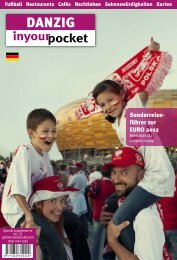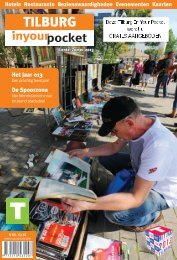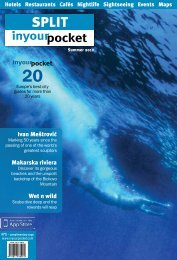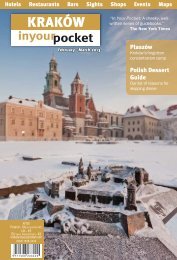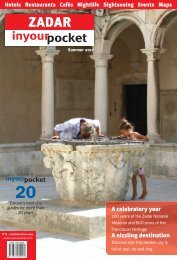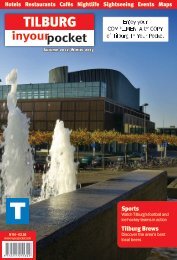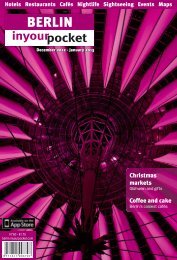7kh 7ul flw\ v prvw dxwkhqwlf 7h[ 0h[ uhvwdxudqw ... - In Your Pocket
7kh 7ul flw\ v prvw dxwkhqwlf 7h[ 0h[ uhvwdxudqw ... - In Your Pocket
7kh 7ul flw\ v prvw dxwkhqwlf 7h[ 0h[ uhvwdxudqw ... - In Your Pocket
Create successful ePaper yourself
Turn your PDF publications into a flip-book with our unique Google optimized e-Paper software.
12 ARRIVAL & TRANSPORT<br />
Arriving by plane<br />
Gdansk Lech Walesa Airport (Port Lotniczy im.<br />
Lecha Wałęsy) ul. Słowackiego 200 (Rębiechowo),<br />
tel. (+48) 58 348 11 63, www.airport.gdansk.pl.<br />
The new terminal 2 forms the centrepiece of this 150<br />
million zloty investment and handles all departures while<br />
the hardly aged terminal 1 has been (or rather is as we<br />
write) converted into a solely arrival terminal. Arriving on<br />
the ground floor of terminal 1 you will be met by a hall<br />
containing ATM machines, some less than competitive<br />
currency exchange desks and a Gdańsk Tourist Organisation<br />
information point where you’ll find <strong>In</strong> <strong>Your</strong> <strong>Pocket</strong><br />
guides and free <strong>In</strong> <strong>Your</strong> <strong>Pocket</strong> mini-guides.<br />
Getting to Gdańsk. You can reach the city by shelling<br />
around 50zł for a taxi from the rank in front of the terminal.<br />
Remember that taxis cost more at night and from Saturday<br />
at 22:00 until Monday at 06:00. Neptun Taxi is the official<br />
taxi firm and can be trusted. Look out for their cars with<br />
the 19686 logo on the side. Be suspicious if offered a<br />
lift by any car not bearing their logo. The cheapest option<br />
is to take bus N°210 towards Orunia, ul. Gościnna to get<br />
to the main Gdańsk Główny train station or bus N°110 to<br />
Gdańsk Wrzeszcz train station. Journey time is 30 to 40<br />
minutes and te bus stop is to the left of the exit next to<br />
the new terminal. The journey requires a one-ride ticket<br />
which costs 3.40zł (from June 3.60zł) and is available<br />
from the driver. You can also buy tickets at the Gdańsk<br />
Tourist Organisation <strong>In</strong>formation desk.<br />
Alternatively, take the Airport Bus (www.airportbus.<br />
com.pl), where 14.90zł tickets can be purchased direct<br />
from the driver (euros accepted). Catch it from the bus<br />
stop to the left of the terminal building, and find your<br />
journey terminating outside the Hevelius Hotel (return<br />
journeys back to the airport available).<br />
Times as follows:<br />
From the airport 01:00, 02:00, 10:30, 11:50, 13:10,<br />
14:50, 18:30, 19:50, 23:40.<br />
To the airport 04:00, 07:30, 09:00, 11:00, 12:30,<br />
16:00, 17:20.<br />
Note that to ensure the bus is running, you should book<br />
a ticket by 20:00 the day before. If there are no tickets<br />
sold the day before the bus does not run. If the bus is<br />
there you are able to buy a ticket from the driver.<br />
Getting to Sopot. There are no buses directly to Sopot<br />
so the most direct option by public transport is to take the<br />
110 bus to Gdańsk Wrzeszcz station. From there take the<br />
local yellow and blue SKM commuter train from platform<br />
1. You’ll need to get on a train running in the direction of<br />
Gdynia and boards on the platform show the time until<br />
the next train. Sopot (the train station in the middle of the<br />
town) is the sixth stop from Gdańsk Wrzeszcz. The most<br />
direct way to reach Sopot is by taking a 19686 Neptun<br />
taxi from outside the terminal building which will cost you<br />
around 60zł normally and more at weekends and at night.<br />
Getting to Gdynia. By public transport you can take<br />
the bus 110 to Gdańsk Wrzeszcz railway station before<br />
boarding a local yellow and blue SKM train to Gdynia<br />
Główna. Alternatively there is bus 510 which runs to<br />
Gdynia 6 times a day (06:45, 10:05, 11:55, 15:00, 18:30<br />
Sat-Sun, 21:15 Mon-Sat and 17:05 Mon-Fri) and costs<br />
3.80zł (from June 4.00zł). Note that this route will run<br />
more frequently during EURO2012. You can buy tickets<br />
directly from the driver. The most direct way is by taxi and<br />
a 19686 taxi will cost you around 100zł to the centre<br />
of Gdynia with prices higher at night and at weekends.<br />
Arriving by train<br />
Arriving by train in Gdansk. When you arrive at Gdańsk<br />
Główny you are a stone’s throw away from Gdańsk Old Town. Left<br />
Luggage is next to the entrance to the main lobby and is open<br />
24hrs although you’ll need the security to open the door from<br />
01:00 - 03:30. The currency exchange (open 24hrs) is in the hall<br />
leading off the main lobby and there are a couple of ATMs. Public<br />
phones are either end of this hall. To get to the town go down the<br />
steps opposite McDonald’s and turn right. Then turn right again,<br />
and head up the steps leading to ul. Podwale Grodzkie. Q The<br />
main building of the station is closed 01:00-03:30, but if you need<br />
to use a locker or buy a ticket the security guard will let you in.<br />
Arriving by train in Gdynia. While the main railway station<br />
receives a well-needed facelift, rail services have been<br />
moved to the local railway station 100m along from the former<br />
station. Tickets for local, regional and national trains can all be<br />
purchased from here. The city centre lies right outside the station<br />
and the main street, ul. Świętojańska is a 10 minute walk<br />
away by turning right out of the station and following ul. 10-go<br />
Lutego. The new station is due to open at the start of June.<br />
Arriving by train in Sopot. Sopot train station is a pretty<br />
basic and run-down affair with two platforms one of which has<br />
been renovated to its original appearance. If you are arriving<br />
from out of town you will be deposited on platform no. 2. To get<br />
to the main station building you should walk to the tunnel at<br />
the northern end of the platform which will bring you out next<br />
to the station building. <strong>In</strong>side are left luggage lockers which<br />
are only available in summer (“money lockers” are available<br />
for smaller storage of your funds) and a fast food outlet as well<br />
as the ticket office. The beach, pier, cafes and restaurants are<br />
all within a 10 minute walk and the nearest tourist information<br />
office is at the entrance to the pier at Pl. Zdrojowy 2.<br />
Gdańsk Główny Train Station A-2, ul. Podwale<br />
Grodzkie 1, tel. (+48) 58 721 54 15, www.pkp.pl.<br />
Gdynia Główna Train Station N-1, Pl. Konstytucji<br />
1, www.pkp.pl.<br />
Sopot Główny Train Station L-3, ul. Dworcowa 7, tel.<br />
(+48) 58 721 37 32, www.pkp.pl.<br />
Arriving by car<br />
There are four main routes leading directly to the Tri-city: the<br />
E28 from the west via Gdynia; the E75 from the south via<br />
Gdansk; the E77 from Warsaw which comes into the city via<br />
Gdansk from the east and the A1 highway also from the south.<br />
Arriving by car in Gdańsk. Parking is available once you<br />
arrive in Gdańsk but remember that the old town area is permit<br />
parking only and you will be fined by the city police for driving into<br />
the old town without a pass. Watch out for the signs marking<br />
the start of the permit parking zone. You will have to use street<br />
parking which is paid for (3zł for the first hour) and you will need<br />
to buy a ticket at the street machine. Alternatively and recommended<br />
if you are planning on leaving the car unattended for<br />
some time, try one of the guarded parking areas listed.<br />
Arriving by car in Gdynia. If you are coming from the south<br />
you will need to negotiate the other two cities first. This is best<br />
done by use of the Obwodnica (ring road) which will get you to the<br />
centre of Gdynia in about 20 minutes. Gdynia itself is the best<br />
laid out of the 3 cities in terms of cars but even parking here is a<br />
challenge these days. Note that paid parking from June will cost<br />
1zł for the first half hour, 2zł for the second 3zł per hour after that.<br />
Arriving by car in Sopot. Whether you are arriving from the<br />
south (Gdańsk) or the north (Gdynia) you are very likely to make<br />
the approach to Sopot via the main Al. Niepodległości road. This<br />
can be very busy during peak times. Sopot city centre is quite<br />
small and, particularly during the summer months, the centre<br />
is snarled up with traffic. There is street parking if you can find<br />
it with the area closest to the centre subject to parking tickets.<br />
Gdańsk <strong>In</strong> <strong>Your</strong> <strong>Pocket</strong> gdansk.inyourpocket.com<br />
Arriving by bus<br />
Arriving by bus in Gdansk. Most national and international<br />
buses arrive at Gdańsk bus station (Dworzec PKS), up<br />
on the hill just behind the train station (Dworzec PKP). Give<br />
the main building a miss and head downstairs to the bus<br />
station hall. The hall is grey and dirty and best shot through<br />
quickly by taking the escalator down to the underground<br />
passage; follow the signs Centrum or Dworzec PKP. Walk<br />
through the passage past all the kiosks selling slippers and<br />
mobile phones until you see the EMPiK bookshop in front of<br />
you. Turn right and go up the steps to ul. Podwale Grodzkie<br />
and the old town lies about a 5 minute walk from there.<br />
Arriving by bus in Gdynia. The building which houses<br />
the train and bus station is currently in the middle of a huge<br />
redevelopment due for completion at the end of May and<br />
meaning, at press time, that there is in effect no bus station<br />
building. Buses stop outside of the development which is<br />
located just on the edge of the city centre. You can get to the<br />
main street, ul. Świętojańska by following ul.10-go Lutego, a<br />
walk that will take you about 10 minutes.<br />
Arriving by bus in Sopot. Sopot does not have its own<br />
international bus station so you will either be dis-embarking<br />
in Gdynia or Gdańsk bus stations and travelling to Sopot<br />
via the local SKM commuter train. See the Getting to Sopot<br />
section in Sopot <strong>In</strong> <strong>Your</strong> <strong>Pocket</strong> for details.<br />
Gdańsk Główny Bus Station A-2, ul. 3 Maja 12, tel.<br />
(+48) 58 302 15 32, www.pks.gdansk.pl.QTicket office<br />
Open 08:30 - 17:00, Sat 08:30 - 16:30. Closed Sun. Note<br />
that on the first two and the last two working days of each<br />
month the ticket office is open 06:30 - 18:30.<br />
Gdynia Główna Bus Station (Gdynia Główna Dworzec<br />
Autobusowy) N-1, Pl. Konstytucji 1, www.pksw.pl.<br />
Arriving by ferry<br />
Arriving by ferry in Gdansk. Polferries from Nynashamn,<br />
60km south of Stockholm, arrive in Gdańsk’s Nowy Port,<br />
about 7km north of the centre. There’s only one ferry in each<br />
direction daily, so the terminal is not very busy. You can buy<br />
a phone card at the kiosk nearby. The currency exchange at<br />
the gate does not offer good rates. Bus N°148 leaves from<br />
outside the main ferry terminal and takes you to Gdańsk<br />
Żabianka train station. From here take an SKM train to<br />
Gdańsk Główny. Alternatively, a taxi ride into the centre of<br />
Gdańsk costs about 25zł. If you have a car then you should<br />
follow signs to centrum, a journey that will take you about<br />
15-30 minutes depending on the time of day.<br />
Arriving by ferry in Gdynia. Stena Line ferries from<br />
Karlskrona, 500km south of Stockholm, arrive at the Gdynia<br />
ferry terminal. There is a currency exchange in the terminal,<br />
and you can also change money on the boat. From the ferry<br />
terminal, take bus N° 150 to Gdynia Główna, the main train<br />
station in Gdynia (from where there are commuter trains to<br />
Gdańsk). A bus ticket costs 2.80zł (3zł from June), and a taxi<br />
to the centre should come to around 20zł. To return there’s a<br />
special line going to terminal N° 570, and the 7 minute journey<br />
costs 3,80zl (4zł from June)from the main railway station. If<br />
arriving by car you should follow the signs for Centrum which<br />
will bring you to the centre of Gdynia in about 10 minutes.<br />
Polferries O-1, ul. Portowa 3, Gdynia, tel. (+48) 58 620 87<br />
61, www.polferries.pl. QOpen 09:00 - 17:00. Closed Sat, Sun.<br />
Stena Line Ferry Port ul. Kwiatkowskiego 60, Gdynia<br />
(Obłuże), tel. (+48) 58 660 92 00, www.stenaline.pl. Q<br />
Open 07:00 - 21:00, Mon, Fri 08:00 - 19:30, Sat, Sun 07:00 -<br />
09:00, 17:00 - 21:00. From June 25 open 06:30 - 21:00, Mon,<br />
Fri 08:00 - 19:30, Sat, Sun 06:30 - 09:00, 17:00 - 21:00. Y<br />
gdansk.inyourpocket.com<br />
ARRIVAL & TRANSPORT<br />
��������������������<br />
��������������������<br />
��<br />
��������������<br />
��������������<br />
�����������������������������������<br />
�����������������������������������<br />
������������������������<br />
������������������������<br />
���������������������������������������<br />
���������������������������������������<br />
����������������������������<br />
����������������������������<br />
�������������������������������������������<br />
�������������������������������������������<br />
���������������������������������������������������������<br />
���������������������������������������������������������<br />
Holger Czukay<br />
Holger Czukay<br />
Born in the Free<br />
City of Danzig on<br />
March 24, 1938,<br />
oddball composer<br />
and musician<br />
Holger Czukay<br />
(pronounced<br />
chook-eye) is<br />
best known as a<br />
founder member of<br />
the art rock band<br />
Can, guardians of<br />
1970s absurdist<br />
Holger Czukay 1972<br />
© Heinrich Klaffs<br />
Krautrock and accidental UK Number 1 stars with<br />
their quirky 1976 hit, I Want More. According to his<br />
autobiography, Czukay taught theology at a dog<br />
school in a former life, and at the age of 12 set<br />
fire to a Russian soldier camp before fleeing to the<br />
West. Studying under the equally eccentric German<br />
composer Karlheinz Stockhausen between 1963<br />
and 1966, Czukay has collaborated with such notable<br />
artists as Jah Wobble, Eurythmics, David Sylvian<br />
and Brian Eno. Still working hard and breaking the<br />
boundaries, those wishing to know more should check<br />
out his two early solo albums, the amusing and funky<br />
Movies (1979) and the 1981 follow up On The Way To<br />
The Peak Of Normal, which shows off Czukay’s sublime<br />
production and tape manipulation skills at their very<br />
best. Holger’s very own website is currently residing<br />
at www.czukay.de.<br />
May - July 2012<br />
13



